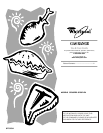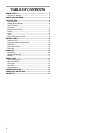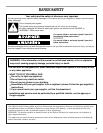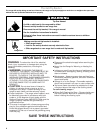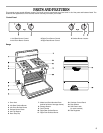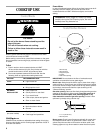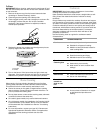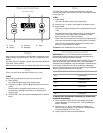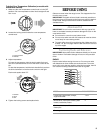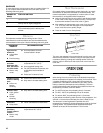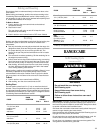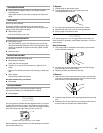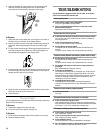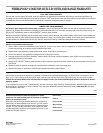
12
Prepare Oven:
■ Remove the broiler pan, grid, cookware and bakeware and,
on some models, the temperature probe from the oven.
■ Remove any foil from the oven because it may burn or melt,
damaging the oven.
■ Remove oven racks to keep them shiny and easy to slide.
See “General Cleaning” section for more information.
■ Hand clean inside door edge and the 1½ in. (3.8 cm) area
around the inside oven cavity frame, being careful not to
move or bend the gasket. This area does not get hot enough
during self-cleaning to remove soil. Do not let water, cleaner,
etc. enter slots on door frame. Use a damp cloth to clean this
area.
■ Wipe out any loose soil to reduce smoke and avoid damage.
At high temperatures, foods react with porcelain. Staining,
etching, pitting or faint white spots can result. This will not
affect cooking performance.
Prepare Cooktop and Storage Drawer:
■ Remove plastic items from the cooktop because they may
melt.
■ Remove all items from the storage drawer.
How the Cycle Works
IMPORTANT:
The heating and cooling of porcelain on steel in the
oven may result in discoloring, loss of gloss, hairline cracks and
popping sounds.
The Self-Cleaning cycle uses very high temperatures, burning soil
to a powdery ash.
The oven is preset for a 3 hour 30 minute clean cycle, but the
time can be changed. Suggested clean times are 2 hours 30
minutes for light soil and between 3 hours 30 minutes to 4 hours
30 minutes for average to heavy soil.
Once the oven has completely cooled, remove ash with a damp
cloth. Do not wipe down any of the inside surfaces until the oven
has completely cooled down. Applying a cool damp cloth to the
inner door glass before it has cooled completely could result in
the glass breaking.
To Self-Clean:
Before self-cleaning, make sure the door is closed completely
or it will not lock and the cycle will not begin. DOOR
LOCKED/CLEANING light will flash until the door is closed.
1.
Push in and turn the oven control knob to CLEAN.
The door will lock within 6 seconds, and OVEN ON and OVEN
HEATING indicator lights will come on.
If the door does not lock, it will try to lock for 1 minute. If the
door fails to lock, the self-cleaning cycle will be canceled and
an error code will be displayed.
2.
Press the “up” or “down” arrow pads to select a clean time
between 2 hours 30 minutes and 4 hours 30 minutes.
During the last 30 minutes of the self-cleaning cycle the oven
will start to cool down. The OVEN HEATING light will turn off
and “COOL” appears in the display.
Once the oven goes below the locked temperature, the OVEN
ON light flashes and DOOR LOCKED/CLEANING light turns
off when door unlocks.
3.
Turn the oven control knob to OFF when finished cleaning.
The OVEN ON light turns off and the time of day appears in
the display.
General Cleaning
IMPORTANT:
Before cleaning, make sure all controls are off and
the oven and cooktop are cool. Always follow label instructions
on cleaning products.
Soap, water and a soft cloth or sponge are suggested first unless
otherwise noted.
EXTERIOR PORCELAIN ENAMEL SURFACES
(on some models)
Food spills containing acids, such as vinegar and tomato, should
be cleaned as soon as the entire appliance is cool. These spills
may affect the finish.
■ Glass cleaner, mild liquid cleaner or non-abrasive scrubbing
pad:
Gently clean around the model and serial number plate
because scrubbing may remove numbers.
PORCELAIN-COATED GRATES AND CAPS
Food spills containing acids, such as vinegar and tomato, should
be cleaned as soon as the cooktop, grates and caps are cool.
These spills may affect the finish.
To avoid chipping, do not bang grates and caps against each
other or hard surfaces such as cast iron cookware.
Do not reassemble caps on burners while wet.
Do not clean in the Self-Cleaning cycle.
■ Non-abrasive plastic scrubbing pad and mildly abrasive
cleanser:
Clean as soon as cooktop, grates and caps are cool.
■ Dishwasher (grates only, not caps):
Use the most aggressive cycle.
SURFACE BURNERS
Sealed Burner models
See “Sealed Surface Burners” section.
Open Burner models
See “Surface Burners” section.
COOKTOP CONTROLS
Do not use steel wool, abrasive cleansers or oven cleaner.
Do not soak knobs.
When replacing knobs, make sure knobs are in the OFF position.
On some models, do not remove seals under knobs.
■ Soap and water or dishwasher:
Pull knobs straight away from control panel to remove.
CONTROL PANEL
Do not use abrasive cleaners, steel-wool pads, gritty wash cloths
or some paper towels. Damage may occur.
■ Glass cleaner and soft cloth or sponge:
Apply glass cleaner to soft cloth or sponge, not directly on
panel.



